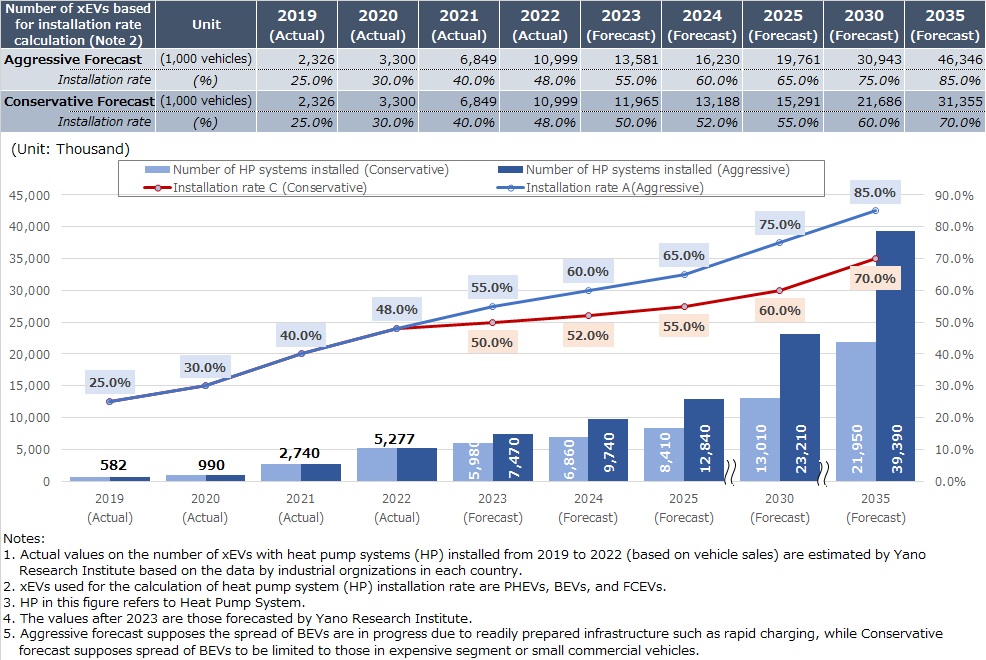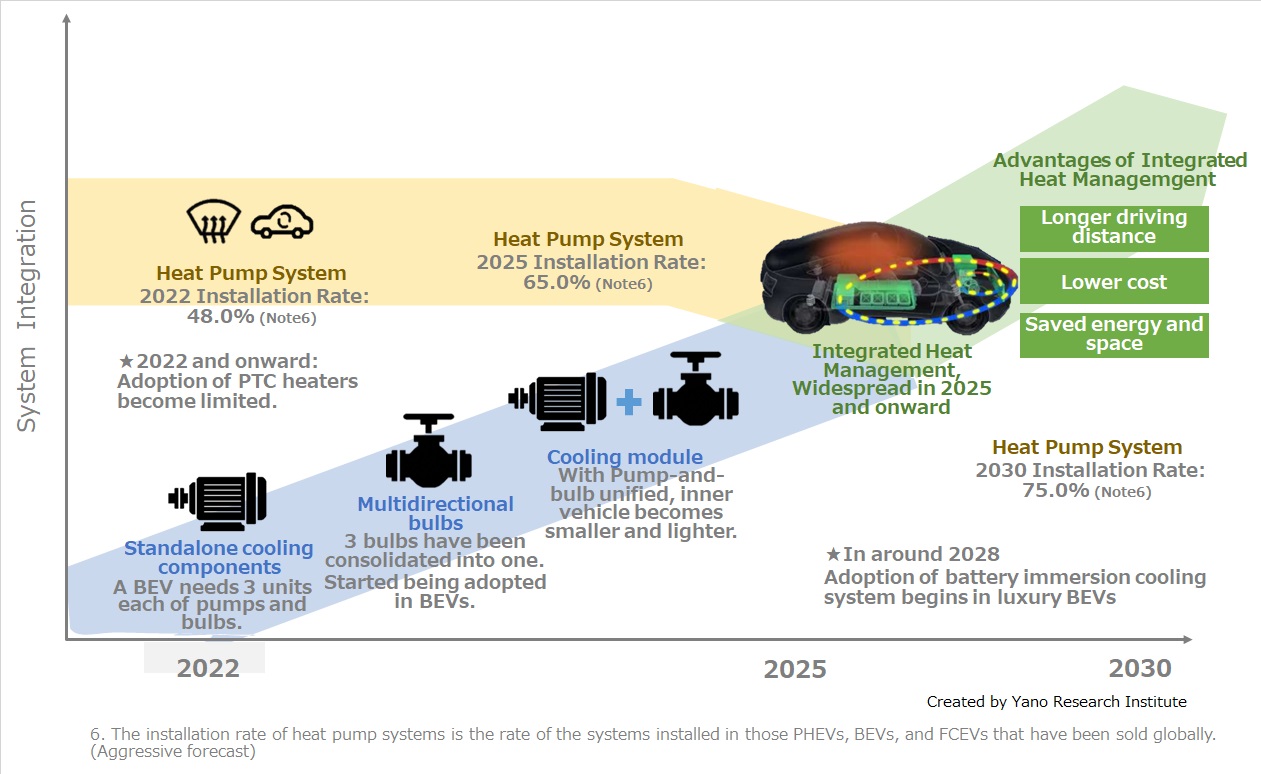No.3296
Global xEV Key Device & Component Market: Key Research Findings 2023
Global xEV Key Device & Component Market Expected to See Integrated Thermal Management to Fully Spread from 2025
Yano Research Institute (the President, Takashi Mizukoshi) has studied the global market for key devices and components geared to the next-generation electric vehicles (xEVs) and found out the market conditions, technological trends and future perspectives for the components, and major manufacturer trends. Here focuses on the technological trends for integrated thermal management, including the installation volume until 2035 for heat pump systems that play core roles of such management and the forecast on the installation rates for target vehicles.


Market Overview
The installation rate of heat pump systems that play important roles for integrated thermal management for xEVs, i.e., HEVs (hybrid electric vehicles), PHEVs (plug-in hybrid electric vehicles), BEVs (battery electric vehicles), and FCEVs (fuel cell electric vehicles) is 48.0% as of 2022, with the mainstream demand at PHEVs, BEVs and FCEVs.
Integrated thermal management that gathers attention due to prevalence of BEVs is the technology to efficiently distribute and make full use of exhaust heat generated from the entire vehicle including motors, inverters, batteries, vehicle-room air conditioners, etc. Utilization of exhaust heat from motors and inverters alleviates the operational burdens at heat pumps, which reduces electricity consumption and eventually contributes to longer driving distance for BEVs. In addition, the development is also underway for controlling heat generation from inefficient driving (*1) of motors and inverters, forecasting rising temperatures by collecting information on road surfaces and driving statuses, and battery temperature control that works in burdensome situations such as when rapid charging is taking place by appropriately cooling the battery or when the vehicle is driving up the slope. Efficient use of exhaust heat generated within vehicles is important for next generation BEVs.
*1) Inefficient driving refers to the driving operation that uses more output than necessary.
Noteworthy Topics
Thermal Management Drawing Attention by BEVs Widespread
As next generation vehicles, i.e., xEVs, differ in power sources from conventional ICE (internal combustion engine) vehicles, devices and components that comprise xEVs must have required specifications and performances. This press release covers the technological trends of integrated thermal management that attracts attention due to xEV prevalences.
Heat management for ICE vehicles has been enough by cooling each auto part, but that for xEVs needs to warm up the vehicle room by utilizing a positive temperature coefficient (PTC) heater, etc. because of small heat sources without engine. However, a PTC heater consumes enormous electricity to affect the driving distance, heat pump systems are drawing attention, instead. Due to cost, the installation rate of heat pump systems from the global sales of BEVs, PHEVs and FCEVs is estimated to be 48.0% as of 2022, but the adoption is expected to expand in various vehicle types as longer driving distance is demanded.
Heat pump systems enable integrated heat management that efficiently utilizes heat from the vehicle by combining it with a pump-and-bulb unified cooling module. They are already applied to some vehicle types and are expected to start permeating in around 2025 because of many advantages such as longer driving distance, lower cost, smaller size, and lighter weight. Anticipating the future environmental regulations, introduction of heat pumps that use CO2 rather than freon for refrigerant geared to air conditioning has begun mainly in European markets. CO2 could be the mainstream refrigerant depending on the future control on per- and polyfluoroalkyl substances (PFAS).
xEVs have other major components such as silicon carbide (SiC) inverters expected to be available for rapid charging and all solid-state batteries characterized as high safety and long life are scheduled to be used from the latter half of 2020s, which are the areas projected for fast evolving technologies.
Future Outlook
In association with wider acceptance of xEVs, for heat pump systems with globally high expectation for rising installation rates, the aggressive forecast (the maximus growth forecast) assumes the installation of the systems to widespread to various vehicle types, with the number of systems installed to be 23,210 thousand units and the installation rate (*2)at 75.0% by 2030, while the conservative forecast (the minimum growth forecast) assumes the installation of the system is limited to some vehicle types, because of high cost which leads heat management to be done mainly by PTC heaters for small vehicles in A or B segment, with the number of systems installed to be 13,010 thousand units and the installation rate (*2) at 60.0% in 2030.
*2) The installation rate of heat pump systems is the rate of the systems installed in those PHEVs, BEVs, and FCEVs that have been sold globally.
Research Outline
2.Research Object: Automakers and suppliers of major components and systems for xEVs
3.Research Methogology: Face-to-face interviews (including online) by expert researchers, interviews by phone, and literature research
xEV Key Device and Component Market
Next generation vehicles, i.e., xEVs in this research are the same meanings as any four-wheeled electric vehicles that are HEV (hybrid electric vehicle), PHEV (plug-in hybrid electric vehicle), BEV (battery electric vehicle), and FCEV (fuel cell electric vehicle), targeting those passenger cars in A to E segments and those small commercial cars weighing 3.5 tons or less. As for major components, electric traction motor, e-motor rotor position sensor (eRPS), power inverter, electric vehicle battery (EVB), current sensor, DC-DC converter, onboard charger, thermal management system, heat pump system, electric water pump, electric oil pump, and electric compressor are targeted. This press release focuses on the technological trends of integrated thermal management, including the installed volume of heat pump systems until 2035 that play core roles of such management and the forecast on the installation rates for target vehicles. The installation rate of heat pump systems indicates the rate of installation for global sales of target PHEVs, BEVs, and FCEVs.
Upon forecasting the global sales of target vehicles, two types of forecasts are prepared: Aggressive and conservative. Aggressive forecast supposes BEVs regardless of segment to widespread as the infrastructure such as rapid charging facilities to be readily prepared, while conservative forecast supposes limited prevalence of BEVs to expensive segments and small commercia vehicles.
<Products and Services in the Market>
Next-generation vehicles (xEVs, i.e., HEVs, PHEVs, BEVs, and FCEVs) limited to passenger cars and small commercial vehicles with the total weight of 3.5 tons or less, and their key devices and components.
Published Report
Contact Us
The copyright and all other rights pertaining to this report belong to Yano Research Institute.
Please contact our PR team when quoting the report contents for the purpose other than media coverage.
Depending on the purpose of using our report, we may ask you to present your sentences for confirmation beforehand.